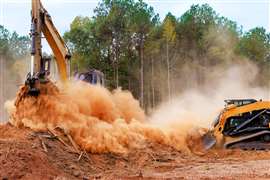Dangerous distraction: SC&RA comment March 2020
14 April 2020

Most would agree that the use of cellphones and similar mobile devices has all but become an international pastime, with many users now also using ear buds or headphones. Much of that technology comes with noise-cancelling features that block out most of the white noise of everyday life. It might be fine on the bus, the train, walking down a busy street, etc., but it isn’t so great on a jobsite.
Without a doubt, the emergent use of headphones, especially among young people, has left a growing number of construction companies around the world scrambling to formulate policies for their use at work.
In the USA, while there is no specific federal regulation that prohibits the use of headphones on a construction site, OSHA issued a letter of interpretation in September last year providing clarification on the matter – stating that headphone use is permissible at managerial discretion “unless such use creates or augments other hazards apart from noise.”
The agency added that these hazards often occur when the headphones mask the natural environmental sounds onsite that need to be heard “especially on active construction sites where attention to moving equipment, heavy machinery, vehicle traffic and safety warning signals may be compromised.”
That said, and despite OSHA not having any formal regulation on this matter yet, it is widely agreed upon and accepted that cell phone use (for entertainment or communication) on active construction sites should not be permitted. It puts both the worker and everyone around him or her at serious, unnecessary risk.
Additional distraction
Much of this awareness and rule setting can be accomplished through training, whether employees agree with it or not. In addition, leadership should also establish early on that cell phone technology, earbuds and-or similar headphones, are not acceptable substitutes for hearing protection.
To that end, OSHA pointed out that some manufacturers may claim that their products are “OSHA approved” or “compliant,” but it’s important to know that, in the USA and, similarly around the world with other regulating bodies, OSHA does not register, certify, approve or otherwise endorse commercial or private sector entities, products or services. Any such claims, therefore, by a manufacturer are misleading.
An additional distraction closely related to the mobile device would be a worker’s urge to simply use it: texting, emailing, calling, etc. Combined with the many noise hazards on a jobsite, workers looking at their phone presents a massive additional risk. And then, if a worker needs to take a call – be it a family emergency or other urgent matter – they might need to take it in private, and could easily end up placing themselves directly in the line of something else as, or even more, dangerous.
There’s also photography. As many companies today encourage their workers to take “good” shots if and when the opportunity presents itself – for social media and website use later – this obviously presents an additional risk, and also might seem contradictory to some workers who’ve been trained not to use tech on site.
Cell phones are also used to document sensitive footage – perhaps a fatal onsite injury – with the information distributed well before the company has a chance to process and manage it. One can imagine the legal challenges in this scenario.
Needless to say, trying to figure out mobile phone management in construction and transport can be a slippery slope. But while industry leaders and regulatory organisations are developing policy, it behooves company owners and applicable onsite management to educate and train employees on the risks at hand and, ultimately, to make it mandatory that if they absolutely need to use their phone, it has to be done offsite.





